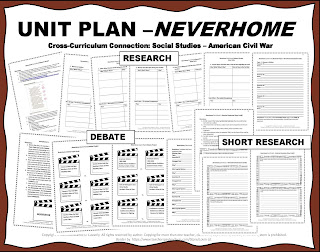Other times, my surfing strikes my Enthusiasm Jackpot Bell. One of the items that makes my Creative Muse clunk me on my brain and exclaim, "Need inspiration? Check these out for ideas!" isn't even in the Lesson Up! category...until now.
But before I get to it, I just have to talk about this huge Home Run Planning Double,
Inspiration Ball #1 - Simply Novel's 2016 Spring Catalog.
This catalog is 22 pages of ELA teacher-planning nirvana. Kristen Bowers has long been recognized for her excellent secondary ELA material on her Simply Novel website and in her TpT store Simply Novel Secondary Solutions. She created this catalog to showcase the abundance of awesome products offered by other ELA Sellers in their TpT stores..Pre-K-2 teachers should browse the
incredible offerings on pages 4-6; Grades 2-5 teachers will find fantastic material on pages 7-10; pages 11-13 offer exciting lessons to those who lead Grades 3-6; teachers in the Grades 6-12 range will sigh blissfully as they peruse pages 3, and pages 14-19; educators whose concentration is Grades 9-12 will find pages 20 & 21 the equivalent of a teacher candy store, and Special Ed teachers' eyes will glow when they see page 12.
Every product links to its own page in the teacher seller's TpT store. If you want to check out a Seller's complete Store, each ad has a store link for that, too. Finally, you will find a Seller Index on page 22..
Inspiration Ball #1 - Amazing Geologist Photographic Bonanza
All of these images are from Amazing Geologist photos
Yesterday, a friend put this picture on Facebook. It knocked the breath out of me, and then followed that reaction by constantly pinging my brain with teaching ideas. The first brain flash I had was to make it my Screen Saver, so I did. My second was to wonder if Chris McCandless from Into the Wild (Jon Krakauer) would have trekked off to Alaska if he came upon this magnificence, Would Meursault from Albert Camus' The Stranger have held onto his existential, "The world is random, chaotic and absurd," views if he gazed upon this design? Those are just two thoughts that I'd mention to my students as I shared these images during their reading.
And then I clicked onto this incredible picture by Ruth Hager offering a close-up of some petrified wood in the Crystal Forest, a part of the Petrified Forest National Park. Now, I'd love Chico's to create one of their flowing-sleeved ponchos with this design. But what item of clothing would Janie from Zora Neale Hurston's Their Eyes Were Watching God want using this colorful motif? I can't even imagine what kind of firestorm would occur if a character from The Crucible (Arthur Miller) showed up in Salem strutting this colorful skirt.
This Elephant Rock formation in New Zealand makes my mind conjure up a mythological story for its existence, Was this elephant turned into a rock for defying the GREAT PACHYDERM?
and, I wonder if this rockin' breakfast plate is a relic from a volcanic eruption, and was discovered by a future geologist searching for the Great American Lost Diner.
Any of the multitude of, "WOW!" photos in this link could be used as
- Mental stretches for Warm-Up or Closure time
- Story Starters
- Poetry Generators
- Descriptive writing topics
- What If ?writings. For example how would a Setting, Plot or a Character from a novel be affected if the author had included the actual place or object in one of the pictures in the novel students were reading? Maybe the picture would set a different Tone/atmosphere, or the location/object would be a major Symbol or the basis for the Theme.
- Inspiration for a personal essay for college applications, or
- Stimulus for a song, or a movie or a play or a painting.
Take a moment and flip through these images, and let them spark your Lesson Idea Muse or jumpstart a brainstorming session with your colleagues. Hopefully these images will offer you some terrific lesson ideas for the following weeks.
To truly save your weekends for the rest of your school year, be sure to check out Kristen Bower's Simply Novel Spring Catalog. Just go to Simply Novel and click on the blue-backed ELA Products Galore *Brand New Catalog* picture like the one I shared in this post.
Enjoy a Teach It Now Day Every Day,

























_Page_01.jpg)
_Page_06.jpg)
_Page_09.jpg)
_Page_04.jpg)
_Page_05.jpg)




_Page_01.png)
_Page_04.png)
_Page_05.png)

